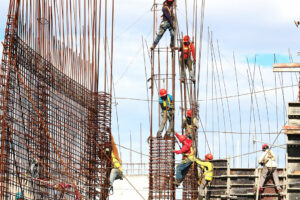Construction firms set for H2 rebound — analysts
LISTED construction companies are expected to rebound in the second half, driven by sector recovery and favorable economic conditions, according to analysts.

By Ashley Erika O. Jose, Reporter
LISTED construction companies are expected to rebound in the second half, driven by sector recovery and favorable economic conditions, according to analysts.
“The outlook for the profitability of listed Philippine construction companies in the second half of 2024 depends on several key factors, including economic growth, infrastructure spending, and interest rates,” Toby Allan C. Arce, head of sales trading at Globalinks Securities and Stocks, Inc., said in a Viber message.
China Bank Securities Corp. Research Associate Neil Andrew L. Maderaje said listed construction firms have a positive outlook for the remainder of the year, driven by the robust construction activities in the country fueled by the government’s infrastructure initiatives and private developments.
In August, the Department of Budget and Management (DBM) said the national government’s spending on infrastructure expanded by 17% in June following increased disbursements for completed public works projects.
“We think that construction activity could accelerate, especially as businesses’ appetite for expansion-related capex (capital expenditure) improves. We believe these macroeconomic developments will strengthen earnings growth prospects for construction firms in the coming quarters,” Mr. Maderaje said in an e-mail.
For the second quarter, listed construction companies posted mixed results.
Megawide Construction Corp. recorded a 30% drop in its attributable net income for the second quarter to P258.66 million, compared with P370.28 million last year. Its second-quarter revenue fell by 8.4% to P6.19 billion, compared with P6.76 billion a year ago, its financial statement showed.
Phinma Corp. widened its net loss for the second quarter to P251.71 million from the P18.61 million loss in the same period last year due to higher expenses for the period.
For the April-to-June period, Phinma recorded a gross revenue of P4.92 billion, marking a 20% increase from the P4.1 billion previously. Its gross expense went up by 24.4% to P5 billion from P4.02 billion in the comparable period a year ago.
Meanwhile, EEI Corp. returned to profitability for the second quarter after recording an attributable net income of P59.77 million, a reversal from a loss of P255.03 million in the same period last year.
EEI’s gross revenue for the second quarter climbed to P4.14 billion, up by 6.7% from P3.88 billion last year, while its expenses went down to P3.9 billion, lower by 5.1% from P4.11 billion last year.
For China Bank Securities’ Mr. Maderaje, construction firms are projected to rebound as the Bangko Sentral ng Pilipinas (BSP) signaled more rate cuts.
“Given recent policy rate cuts and the outlook for more cuts heading into 2025, we think that construction activity could accelerate,” he said.
BSP Governor Eli M. Remolona, Jr. has said that the Monetary Board could implement two more rate cuts at its next two meetings scheduled for Oct. 16 and Dec. 19.
The central bank began its easing cycle in August by cutting the target reverse repurchase rate by 25 bps to 6.25% from the over 17-year high of 6.5%. This was the first time the BSP reduced rates in nearly four years.
“As the economy grows and inflation cools, the government may ramp up infrastructure spending. Listed construction companies, especially those involved in public infrastructure projects, could see significant earnings growth from increased government investments,” Mr. Arce said.
According to a BusinessWorld poll of 15 analysts conducted last week, the median estimate for the September consumer price index (CPI) is 2.5%.
If realized, September inflation would be significantly slower than 3.3% in August and 6.1% in the same month a year ago.
“With inflation moderating, the cost of raw materials like steel, cement, and fuel may stabilize, preventing the sharp increases seen in previous years. This would allow construction firms to maintain or even improve their profit margins by better managing project costs,” Mr. Arce said.
















